For more than a century, the RFA has been essential in allowing the Royal Navy to operate globally.
A vital asset for Britain’s expeditionary forces, the RFA has a long history supporting British forces throughout the world.
In 1905, during the last years of the age of coal as the main propulsion for warships, the Royal Fleet Auxiliary (RFA) was established to provide the much-needed resource to the British naval forces. The period of the coal-fired steam engines required a complex network of bases with coaling facilities or a vast number of auxiliary ships to supply coal where bases were not available.
Within this context, the Royal Navy had at its disposal the largest and most complete system of coaling stations around the world. Britain’s Empire served as a valuable asset for its territories were in every inhabited continent. British naval power projection was secured through the imperial coaling bases.
Thus, the numerous naval and coaling stations meant that during its first years, the role played by Royal Fleet Auxiliary was relatively discreet. However, before the British Government widely recognised its relevance, the RFA participated in many operations around the globe. The fleet supported Allied forces in the Russian Civil War, acted as part of humanitarian assistance in the 1923 Great Kanto Earthquake and the 1928 Corinth Earthquake, and supported international naval patrols during the Spanish Civil War (1936-1939) that were enforcing maritime law and preventing acts of piracy. Before these operations, the Royal Fleet Auxiliary served extensively during the Great War. Amongst its duties, the RFA was one of the forces responsible for the transportation of oil from the United States to Britain, an essential task for the British war effort.

The RFA’s role as a civilian fleet with the primary purpose to support the Royal Navy to carry on its military operations around the globe would become extremely relevant during the Second World War. The conflict required the British naval forces to stay at sea for longer periods than had been the case since the early days of the Revolutionary and Napoleonic Wars. This necessity required more auxiliary ships than onshore installations. Beyond that, the fleet had some bases exposed to threats from air and naval power. Lastly, the increasing size of the British land forces along with the requirement to transport troops to different theatres of war led to a significant expansion in the total number of vessels under the RFA’s Blue Ensign.
During the Second World War, the RFA was part of more than 30 planned operations, acting as a support fleet from the North Sea against Germany to the Pacific Ocean against the Empire of Japan. Throughout the conflict, the number of Auxiliary vessels grew steadily as some ships were “taken up from trade” – requisitioned by the British Government – and others were specifically designed and ordered by the Admiralty. Some of these vessels could be identified as proper warships operated mainly by a civilian force.
After the end of the war, the role played by the Royal Fleet Auxiliary had been widely recognised by Britain’s strategists and chiefs of staff. Thus, the RFA became the main branch responsible for assisting the Royal Navy and Royal Marines deployments around the world and improving the readiness of these global deployments, offering logistics and other operational support.
The next significant conflict that the RFA would prove its usefulness is the Korean War (1950-1953). The peak of the British forces involved is roughly 14,200, but during the three years of war, more than 90,000 Britons served in Korea through all the branches of the Armed Forces.
Following the official decision to deploy forces, the RFA was tasked with transporting part of the troops and supporting the British Far East Fleet. However, its main purpose was to assist the Royal Navy’s aircraft carrier present in the region. Five carriers served in one moment or another in the Korean War: HMS Ocean, Glory, Theseus, Unicorn and Triumph. Support was also delivered to allied forces, especially those under the banner of the “British Commonwealth Forces Korea” (BCFK) which included Australia, New Zealand, Canada and India. More than 20 ships of the Royal Fleet Auxiliary served during the conflict.
It is worth mentioning that while the British Government decided to join the US-led United Nations Forces in Korea, Britain was facing an already 12 year-long guerrilla war in the Malay Peninsula. Inland operations and jungle warfare dominated the Malayan Emergency. Thus, during the Emergency, the role of the RFA was restricted to the transportation of troops and refuelling of Royal Navy vessels.
Three years later, in 1956, the RFA would be mobilised for the Operation Musketeer (later named as ‘Musketeer Revise’). Aiming to regain control of this strategic passage the Anglo-French plan for the invasion of the Suez Canal was the culmination of tensions with Egypt ruled by Abdel Nasser that had nationalised the canal in disagreement with the British and French interests and previous accords between Egypt and Britain. Israel also participated in the planned intervention.
The Suez Crisis witnessed a significant British force of roughly 45,000 troops, and the RFA was present through more than 35 vessels. Although the military objectives were within Britain’s grasp, the whole operation was cancelled following the lack of support from the United Nations and, especially, from the United States that threatened to damage Britain’s economy by selling the American Government’s pound sterling bonds.
The relevance of the RFA would only increase in the years after the conflicts mentioned above. From the independence of the Indian subcontinent to the decolonisation process of the 1960s, the availability of the imperial naval bases decreased steadily. Despite the acts of the British Government to secure defence agreements with the newly independent nations, the results could not cover the losses. Therefore, the end of the Empire resulted in the increasing dependence on the RFA to support the Royal Navy in routine deployments. Any armed conflict – especially beyond Europe – would require an adequate auxiliary force.
In 1982, a crisis emerged in the waters of the South Atlantic. Argentina’s governing “Military Junta” led by General Leopoldo Galtieri had been facing unpopularity due to its ruthless persecution of oppositionists, cassation of political rights and the mishandling of the Argentinian economy. When Galtieri ascended to power in December 1981, the Junta deemed that a move to gain widespread “national unity and support” was necessary. The invasion of the Falklands Islands had been planned by Buenos Aires to be a “fait accompli”, believing that Britain would not respond with military force. When the Task Force sailed to the region, the Argentine Junta began to realise that its perception that Britain was disengaging from the South Atlantic was erroneous. In part, this Argentine idea of disengagement has its roots in the Defence Review of 1981 (Nott Review) that hit the Naval Services with severe cuts, including the planned retirement without replacement of HMS Endurance the last permanent British naval presence in the area.
The plans to retake the Falklands would require the Royal Navy as the leading force. Therefore, the Royal Fleet Auxiliary was going to have a strategic and decisive role. Considering the personnel of the three branches of the Armed Forces, Britain mobilised roughly 29,000 troops with more than 110 ships of the Royal Navy, RFA and others taken up from trade. The RFA was represented through 22 vessels. The Naval Services transported roughly one million tons of fuel, freshwater, general goods, refrigerated food and medical equipment. This represented more than 95% of all the naval logistical effort of the Falklands War. The British Ascension Island proved to be essential as a staging point for the forces involved in the conflict and contributed to reducing costs of Britain’s troops sent to the region.
The ships under the Blue Ensign were present in Operation Paraquet – the recapture of South Georgia – and in Operation Corporate – the main objective of retaking the Falklands. The largest naval war since 1939-1945 cost the RFA the loss of the Round Table-class landing ship logistics (LSL) Sir Galahad on 8 June, later on 21 June her hull was sunk as a target by the submarine HMS Onyx, and her resting place was declared a war grave. RFA Sir Tristram, of the same Round Table-class, was severely damaged in the same day as Sir Galahad. However, she returned to Britain after the war and served until 2005 but continued to be used as a training platform by the Special Boat Service and other branches of the Special Forces.
After 74 days of conflict, Britain achieved victory in the South Atlantic. The British forces faced 255 killed in action and 775 wounded.
Moreover, other important losses were two frigates (HMS Antelope and HMS Ardent), two destroyers (HMS Sheffield and HMS Coventry), one landing ship (RFA Sir Galahad) and one container ship. In short, the Falklands War showed the vulnerability of surface vessels to anti-ship missiles and submarines. It also proved the centrality of the naval forces when projecting power abroad and consequently reminded the British Government about the necessity to maintain a capable RFA and Royal Navy.
In the next decades, the Royal Fleet Auxiliary would be part in multiple operations. When the United States decided for the invasion of Granada, a former British colony in the Caribbean, Britain sent HMS Antrim and RFA Pearleaf to protect British citizens. The Gulf War also requested the deployment of RFA to support the Allied Coalition forces in the Persian Gulf. In 1997, RFA Black Rover was involved in the Operation Caxton a voluntary evacuation of the British Territory of Montserrat, which was facing a volcano eruption since 1995. The RFA was also deployed to support the British and Allied operation (Kosovo Force or KFOR) in the Balkans, with five RFA vessels sent in 1999. In 2000, Britain intervened in Sierra Leone on the side of the democratically elected government.
The RFA was once again tasked to support the Royal Navy operation in the area. Roughly 4,500 troops fought in the country at the peak of the conflict that ended shortly after the British intervention.
After that, Britain would participate in the invasion of Afghanistan (2001) and Iraq (2003). The invasion of Iraq (code-named Operation Telic) saw the commitment of 46,000 British troops. The Royal Navy and the RFA contributed with 5,000 personnel, with 13 ships from the RFA supporting the deployment of the Royal Navy, 26,000 troops of the Army and 4,000 of the Royal Marines. It is worth mentioning that the British maritime forces were centred on HMS Ark Royal (the Flagship) and HMS Ocean. In total, 19 Royal Navy surface vessels were present in the first months of the invasion.
Beyond the military operations, the Royal Fleet Auxiliary has a tradition in providing aid and disaster relief to British territories and allied nations overseas. Within this context, early examples are the mentioned aid and relief operations in the Great Kanto Earthquake of 1923 and the Corinth Earthquake of 1928. The 2010 Operation Panlake in Haiti, Operation Gritrock in 2014 during the Ebola outbreak in Sierra Leone and the yearly presence in the Caribbean during the hurricane season are relatively more recent examples. Since the 1920s, the fleet has assisted in many natural disasters in almost every inhabited continent.
Currently, 13 ships are part of the Royal Fleet Auxiliary displacing 337,000 tones with almost 2,000 personnel. The RFA’s newest acquisition is the four large replenishment tankers of the Tide-class. Each tanker has a displacement of 39,000 tonnes and 200.9 metres in length, meaning that these ships are similar in size to the retired Invincible-class carriers (roughly 22,000 tonnes and 210 metres). The Tide-class is capable of underway replenishment and were ordered to be capable of assisting the two new Queen Elizabeth-class aircraft carriers. Differently from its predecessor of the Rover-class and Leaf-class tanker, the ‘Tides’ are double-hulled to minimise or avoid fuel being lost when the outer hull is damaged.

This characteristic also enables the class to be deployed to hostile areas of operations without the same level of risk that the Rover and Leaf-class faced. Additionally, a Chinook helicopter can land on the flight deck of the Tides. In spite of this new acquisition, the RFA – as happened to the Royal Navy – would witness part of its fleet being retired without replacement. One example is RFA Diligence, a former “forward repair ship”.
Moreover, the RFA has two “fast fleet tankers” through the Wave-class. The RFA Wave Knight and Wave Ruler were both commissioned in 2003 to replace the Ol-class tankers. Before that, between 1993 and 1994, the RFA commissioned two Fort Victoria-class multi-role replenishment ship. This class has the combined role of a tanker and a store supply vessel. Initially, six were planned, but only two (Fort Victoria and Fort George) survived the defence cuts of the early 1990s. One of them, RFA Fort George, would be decommissioned in 2011 leaving Fort Victoria as the only ship of the class in active service. Lastly, there are two Fort Rosalie-class of replenishment vessels, Fort Rosalie and Fort Austin. The latter was deployed to support the British military operation during the Sierra Leone Civil War. The Fort Rosalie-class is expected to be replaced by the “Solid Support Ships” programme.
The Royal Fleet Auxiliary has three “Landing Ships Dock Auxiliary”, essential for Britain’s amphibious operations and power projection around the world. Commissioned between 2006 and 2007 the Bay-class land ships were a force of four vessels (Largs Bay, Lyme Bay, Mounts Bay and Cardigan Bay). However, RFA Largs Bays would not survive the defence cuts set by the British Government in 2010.

She was decommissioned in 2011 and sold to Australia, entering service as HMAS Choules. Each vessel has space 24 Challenger II tanks and can accommodate roughly 350 in normal conditions or 700 if necessary for urgent operations. Although with no hangar for long-term transportation of helicopters, the flight deck can receive Chinooks and Merlin helicopters. If necessary, a temporary structure can be raised to house helicopters up to the size of a Merlin.
Beyond the Bay-class, there is the Aviation Training and Primary Casualty Receiving Ship, RFA Argus. When she was commissioned in 1981, her role was mainly as an Aviation Training Ship (ATS), but since the Gulf War of 1991 Argus’ function has shifted to a mostly Primary Casualty Receiving Ship (PCRS). Argus has a flight deck to accommodate five Apaches or four Merlins. Additionally, she can receive 200 Medical and Nursing staff when necessary. It worth noting that Argus is not recognised as a “Hospital Ship”.
Beyond the 13 ships of the RFA, the Ministry of Defence (MoD) has five ships under a charter. Four Point-class vessels are tasked with on/off sealift duties, meaning that they are designated to transport wheeled cargo. Lastly, there is the Maersk Rapier, a commercial taker responsible for transportation of oil to British and allied depots. The five ships have a total displacement of almost 130,000 tonnes. Lastly, it is worth mentioning the vessels operated by Serco Marine Services in support of the Royal Fleet Auxiliary, Royal Navy and Royal Marines, especially for moving in or out of port and transporting stores and munitions.
According to the Royal Navy, the RFA “delivers worldwide logistic and operational support to Royal Navy operations” and is considered as “an essential element of how the Royal Navy operates with freedom around the globe”. As explained above, the RFA also has a role in counter-piracy, law enforcement and disaster relief and evacuation operations.
Therefore, every British Government should recognise the relevance of the Royal Fleet Auxiliary to Britain’s global reach and keep it as an adequate supporting force. The combination of adequate British military installations in some of its Overseas Territories and allied nations and a Royal Fleet Auxiliary that is recognised for its centrality can produce positive results for Britain’s global interests.
However, defence cuts that aim to reduce the RFA have a significant potential to cripple the military reach of the United Kingdom for they directly affect the deployment of forces and their expeditionary capabilities. As the Falklands War has shown, the Royal Fleet Auxiliary should be regarded as essential to any Task Force and therefore part of the main assets required to defend and protect British interests overseas.


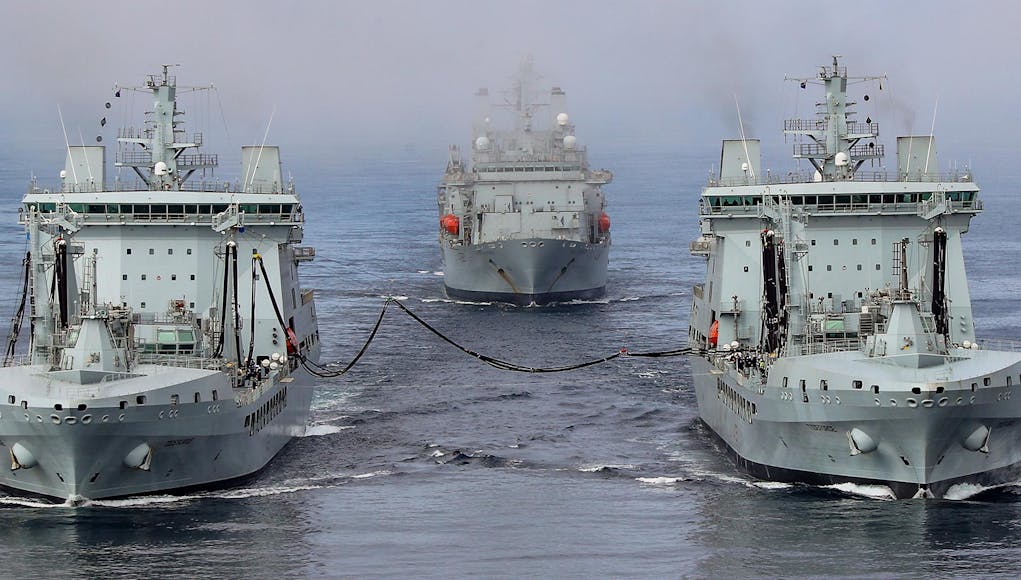



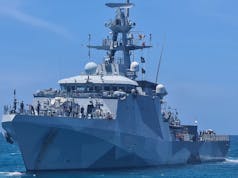
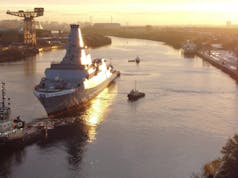
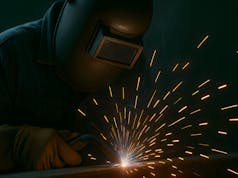
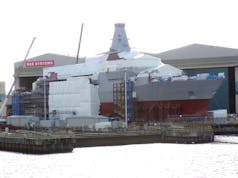




Excellent and timely article. As stated, the RFA is essential. Without it, 2 of the pillars of the RN fail – Carriers Group and Amphibious / RM.
It should be one area where there is expansion.
Agreed, no point in having high-end CBGs deployed globally if they have to rely on shore bases for resupply.
In addition to the two pillars you mention, our soft power projection is augmented massively by the RFA and it shouldn’t be discounted- particularly when it comes to Commonwealth relations.
Agree. I hope closer alignment of DFID budget might find more vessels.
Definitely. Also, with their typically large stores capacity and relatively small crew complement and RFA vessel is more often than not the most appropriate UK vessel for a disaster relief mission. I know it’s a bit of a broken record but the foreign aid budget really should be contributing to expanding the RFA fleet and meeting a worthwhile proportion of the running costs.
Foreign aid should also be funding either a new hospital ship or (my preference) research into incorporating a good core hospital facility into newly designed RFA vessels (diagnostics, pharmacy, ITU and operating theatre spaces plus some lower dependency beds) with a designed-in capability for the core facility to be augmented with modular units in adjacent storage spaces to scale the capacity of the core facility quickly and significantly as required (and obviously ultimately funding the incremental cost of the implementation of that strategy if it was found to be practical and cost effective). Right now having multiple ships capable of fielding an Argus-like level of hospital capability would be very, very useful.
Unlikely as it may seem Julian there is a paper circulating RUSI that says that Dominic Cummings, Boris’s chum, wants to look into ways of using the OAB more usefully, including within the MOD. It will be part of the review, now deferred of course. Fingers crossed
Stay safe everyone.
And that is welcome.
Nice to see you posting Geoffrey.
Thanks Daniele.
A lot to do recently with business and the family. I Keep safe.
The recent BMT MRSS would make a useful RFA funded from the DfID budget.
But also Cammell Laird had a proposal a short while ago for such a vessel. It would incorporate training for UK seafarers (which would be useful all around), disaster relief and could be used in the event of wartime.
https://www.clbh.co.uk/new-contracts/cammell-laird-backs-plans-150m-disaster-relief-ship
Hi folks,
What a good article and good read. The RFA demonstrate the important role of such a service, this obviously gives the UK an edge that many militaries don’t have, coupled with the various bases around the globe makes the UK one of very few nations to project, deploy and sustain a force.
Cheers and stay safe,
George
Why is the RFA not part of the RN?
Technically part of the MOD but not within the RN. That said its all semantics.
Another fine example of just how good U.K. plc is. Long may it continue ??. Excellent article.
‘However, RFA Largs Bays would not survive the defence cuts set by the British Government in 2010.’
Among many very short sighted policy decisions taken at that time that will cost the country more in the long run.
Barking! For saving of, what was it, 10 million a year?
The Bays are amongst the most useful assets we have!
As a deckhand who served 17 years in the RFA i know first hand what the capability of the service is
Whithout doubt the RN could not do what is required of them without them
It annoys me sometimes when i see programs on the box about warships and very rearly do you see or any mention of said service
And also only yesterday the head of the armed forces talking at the daily briefing mentioned HMS Argus That really annoys me but what do you expect he was army and dosnt know the differance as both services are painted grey so i suppose he can be forgiven LOL
I served on RFA Regent during the Falklands war and it wasnt a nice site seeing the Atlantic Convayer burning
I served on various types of ships and had the fortune to go around the world when we had a fleet to mention
The Cold War was interesting but i felt safer then that i do now
Someone should post this article to the CDS, who referred to “HMS” Argus yesterday in the daily briefing. Something that really irritates personnel in the RFA.
Really? Good Lord, didn’t realise that.
He is the principle architect of Strike so one wonders.
FSS comp to be reopened later this year according to Def Sec.
Great article. It pretty much sums up the RFA.
I agree with Barry as a serving member of RFA for quite some years now we never get the recognition we deserve and whenever an MP declares in parliament that they will be sending a ship to a trouble spot around the world, this invariably involves an RFA hull. We are the poor relation to the RN and have to repeatedly fight for fair pay rises and continually do this time and time again, which is appalling considering we completed close to 80 percent of RN commitments last year. I believe that at least 3 RFA ships are currently in the top 5 critical units supporting HM defence interests globally.
The RFA punch well above their weight at a fraction of the costs and with much fewer personnel.
Good Morning All. A great article. I would think that a debate worth having would be-“Should the RFA be merged with the Royal Navy? Are there any good reasons to retain the RFA as a separate organisation or is the present setup a relic of a previous era and now is perhaps the time for change? Do not most other Navies world wide incorporate the tasks and vessels per the RFA under one banner? What would be the main advantages/disadvantages of such a merger and would it result in economies overall?
Geoff
Look up the US MSC
Will do thanks barry
Fantastic article. The RFA really are the feather in the cap of UK Armed Forces, but too often they are forgotten. Its down to the RFA that the UK remains a more capable military at long distance, independent deployments than almost any other country bar the US. They can’t be allowed to slip through the cracks
The RFA are a very important SOVEREIGN capability/requirment and surely without them make for a less sovereign capability/requirment for those frigates destroyers and aircraft carriers, does it not?
Simply put, no cuts to the RFA. ARGUS to be retained and maintained or replaced like for like. A unique and invaluable asset. I have a fond affection for the RFA, just so British and a great part of our maritime heritage, and essential for now, and future operations.
Very good article.